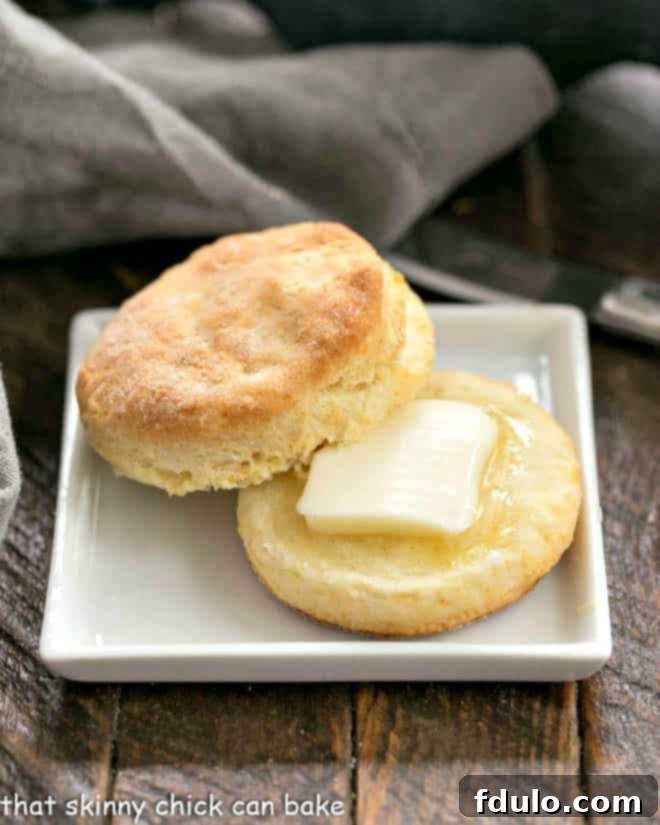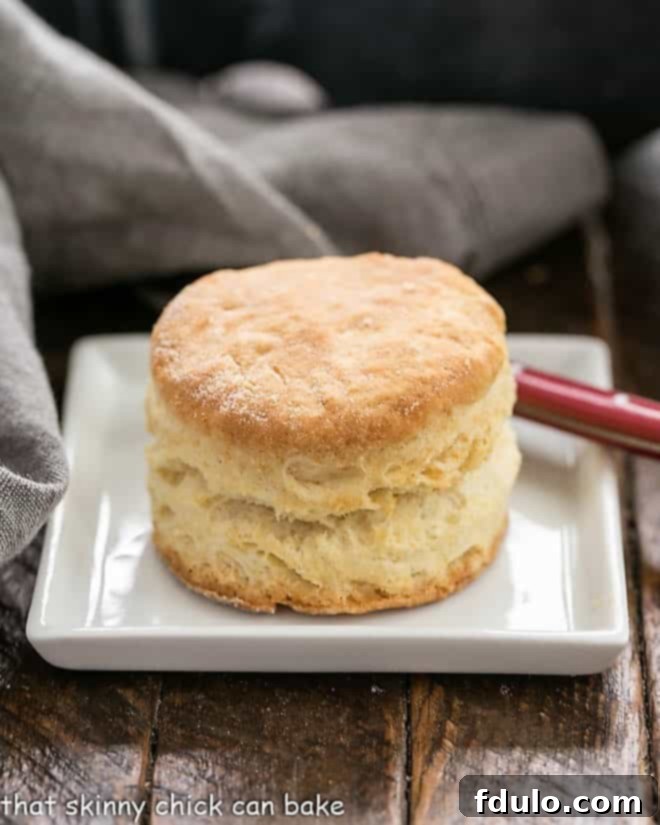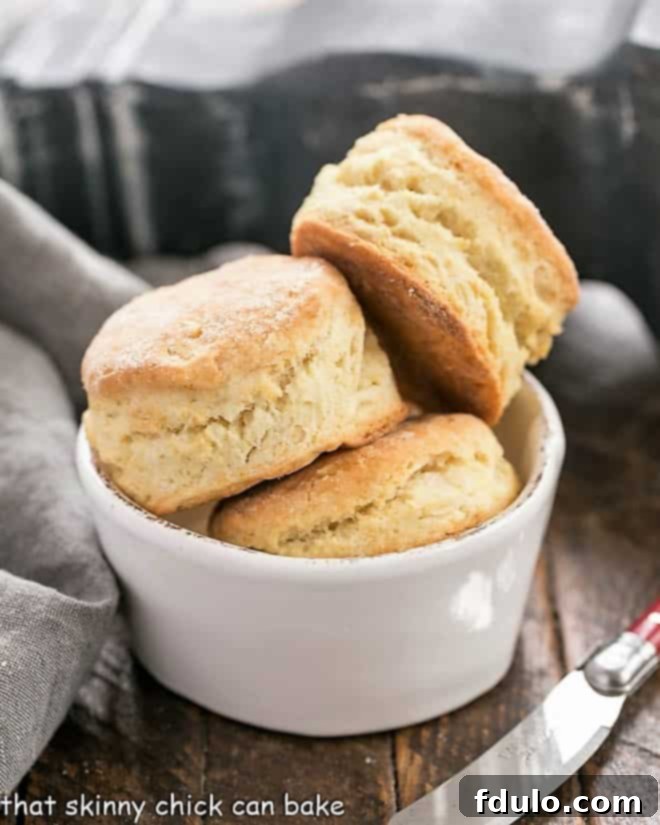Searching for the ultimate Easy Biscuits Recipe that guarantees an incredibly delicious outcome? This unique Buttermilk Biscuits Recipe employs a lamination technique, similar to that used in puff pastry, ensuring astonishingly flaky layers!
If you’ve ever yearned to create homemade biscuits that evoke the comforting taste of a true Southern grandma’s kitchen, your search ends here. I’m delighted to share my perfected homemade biscuit recipe, packed with invaluable tips and tricks designed to guide you every step of the way. Using simple, accessible ingredients and following our detailed instructions, you’ll be baking batches of tender, mouth-watering biscuits fresh from your oven in no time.

Unlock the Secret to Perfect Flaky Buttermilk Biscuits: Why This Recipe Stands Out
Achieving truly exceptional biscuits goes beyond simply cutting butter into flour. While I have a few go-to recipes for leftover buttermilk, like Ina’s corn muffins, this method for tender buttermilk biscuits truly elevates the art. Inspired by the innovative techniques of Cook’s Illustrated, this recipe ventures beyond traditional approaches to deliver an unparalleled texture and flavor profile. It’s designed to transform your baking experience, moving you from good biscuits to truly great ones, making it a staple in any baker’s repertoire.
- The Lamination Magic: Instead of merely cutting in cold butter, this recipe instructs you to flatten pieces of butter with your fingers, creating thin, delicate sheets. These butter sheets are then strategically dispersed throughout the biscuit dough. When baked, the butter melts and releases steam, forming incredible air pockets that mimic the desirable flakiness found in puff pastry and perfectly tender pie crusts. This technique is fundamental to achieving those coveted distinct layers that define a truly magnificent biscuit.
- The Power of Extreme Cold: To further enhance the flakiness, the dough mixture is briefly chilled in the freezer before shaping. This crucial step ensures that both the butter and shortening remain extra cold, preventing them from fully incorporating into the flour prematurely. Keeping the fats solid for as long as possible in the baking process is key to creating those beautiful, airy pockets.
- Strategic Folding for Layers: A technique often reserved for complex pastries, this recipe incorporates a simple yet effective folding method. The dough is folded into thirds, providing multiple opportunities to build distinct, visible layers. This process, known as lamination, is simplified here compared to traditional pâte feuilletée, requiring only one “turn” without extensive additional chilling. This ingenious shortcut delivers maximum flakiness with minimal effort, making extraordinary biscuits achievable for home bakers.
- The Buttermilk Advantage: Beyond its role in leavening, buttermilk adds a unique tang and incredible tenderness to the biscuits. Its acidity reacts with baking soda, producing carbon dioxide gas that helps the biscuits rise, while also breaking down gluten strands, ensuring a soft, delicate crumb that melts in your mouth.

Mastering Biscuit Perfection: Essential Expert Tips
Creating truly spectacular biscuits is an art form, but with these expert tips, you’ll be well on your way to baking batches that impress every time. From ingredient preparation to shaping techniques, each piece of advice is designed to maximize flakiness, tenderness, and flavor.
- PRO-Tip: The Cornerstone of Flakiness – Keep it Cold! The single most critical factor for flaky biscuits is maintaining very cold butter, shortening, and buttermilk. Start with butter that’s firm from the fridge and cut it into small pieces or tablespoons. After incorporating the shortening and rubbing in the cold butter, place the bowl in the freezer for about 15 minutes. This rechilling step is vital for preventing the fats from melting into the flour too soon. Likewise, keep your buttermilk in the refrigerator until the very moment you’re ready to add it to the dry ingredients. This meticulous attention to temperature ensures the fats create steam, pushing apart the layers of dough during baking.
- A Touch of Sweetness: I’ve incorporated a tablespoon of sugar into this recipe to delicately balance the salt and leavening agents with a hint of sweetness. This subtle addition enhances the overall flavor without making the biscuits overtly sweet. If you envision using these versatile homemade biscuits for a classic dessert like strawberry shortcakes, feel free to increase the sugar by another tablespoon or so to suit your palate.
- PRO-Tip: The Gentle Touch – Avoid Overmixing. This might be the most common pitfall for new biscuit bakers. Overmixing the ingredients develops the gluten in the flour, leading to tough, dense biscuits instead of light, tender ones. Your goal is to preserve those thin flakes of butter and minimize gluten formation. Mix just until the dough barely comes together, and a few dry spots remain. A light hand is your best friend here.
- PRO-Tip: The Freshness Factor – Check Your Baking Powder. Baking powder is a leavening agent that loses its potency over time. Unlike baking soda, which is often used more frequently, baking powder can sit in the pantry and expire before you realize it. Always check the date on the can. If in doubt, buy fresh baking powder. You can also test its freshness by mixing a teaspoon with a quarter cup of hot water; it should fizz immediately. This recipe also calls for baking soda, which tends to have a much longer shelf life, but ensuring fresh baking powder is crucial for a proper rise.
- Mastering the Fold: The Lamination Technique Simplified. The folding of the dough, or lamination, is a novel concept for many home cooks but is surprisingly straightforward. Ensure you work on a lightly floured surface to prevent sticking. Roll the dough into a large rectangle. Then, fold one-third of the dough over the middle third, and then fold the remaining one-third from the other side over this double layer. This creates three layers of dough. Gently roll this rectangle until it’s approximately 1 inch thick. Remember to work quickly to keep the dough as cold as possible during this process.
- Precision Cutting for Perfect Rise: Use a sharp, round cutter with a diameter of 3 inches or less. A sharp edge ensures a clean cut without tearing the dough layers.
- PRO-Tip: Cut Straight Down, Never Twist. This is a crucial step for maximum lift. When cutting biscuits, press the cutter straight down through the dough without twisting. Twisting seals the delicate layers of butter and dough together at the edges, preventing them from puffing up and separating into those beautiful flakes during baking. If the cutter sticks, dip it lightly into flour before each cut.
- Serving Inspiration: These biscuits are incredibly versatile! They’re perfect alongside a bowl of my Homemade Chicken Pot Pie, or as a base for rich sausage gravy, or simply with butter and jam.

Frequently Asked Questions About Buttermilk Biscuits
In the United States, a biscuit is a type of small, quick bread leavened with baking powder or baking soda, rather than yeast. They are typically savory, though some variations can be subtly sweet, characterized by a tender interior and a light, often flaky texture, making them a staple in Southern cuisine.
Several factors can lead to disappointing biscuits. A common culprit for biscuits that don’t rise is expired baking powder; as a leavener, it loses its potency over time. Since baking soda is often used more frequently, baking powder might expire unnoticed in the pantry. Furthermore, baking powder generally has a shorter lifespan than baking soda. Another major cause of tough biscuits is over-working the dough. Excessive mixing develops gluten, which should be minimized for tender, airy results. Always use a light hand when combining your ingredients.
The word “biscuit” derives from a two-word French phrase, “bis cuit,” which literally translates to “twice cooked.” This term refers to a historical method of baking where bread was cooked twice to remove moisture, thereby making it incredibly durable and resistant to spoilage. This technique was commonly used by sailors many years ago to preserve food for long voyages.
While buttermilk is ideal for its acidity and flavor, you can make a substitute at home. For every 1 cup of buttermilk, combine 1 cup of regular milk (preferably whole or 2%) with 1 tablespoon of lemon juice or white vinegar. Let it sit for 5-10 minutes until it slightly curdles, then use as directed. Be aware that the flavor might be slightly different from true buttermilk, but it will still provide the necessary acidity for the leavening reaction.
For light and tender biscuits, a low-protein flour like bleached all-purpose flour or, even better, a soft winter wheat flour (often labeled as “biscuit flour” or “self-rising flour” if it includes leavening and salt) is recommended. The lower protein content minimizes gluten development, which contributes to a more delicate crumb. If using self-rising flour, omit the baking powder, baking soda, and salt from the recipe and adjust the buttermilk as needed.
Once baked and cooled, biscuits are best enjoyed fresh. However, if you have leftovers, store them in an airtight container at room temperature for up to 2-3 days. For longer storage, biscuits freeze exceptionally well. Arrange cooled biscuits in a single layer on a baking sheet to freeze individually, then transfer them to a freezer-safe bag or container. They can be stored for up to 3 months. Reheat frozen biscuits in a preheated oven at 300°F (150°C) for about 10-15 minutes, or until warmed through.
Explore More Delicious Quick Bread Recipes!
If you’ve fallen in love with the simplicity and comfort of baking quick breads, you’re in for a treat! Here are more delightful recipes that are easy to prepare and perfect for any occasion:
- Oreo Scones from Created by Diane
- Brazilian Cheese Bread
- Raspberry Cream Scones
- Goat Cheese Biscuits
- Herbed Buttermilk Biscuits
- Brown Sugar Apple Bread
- Zucchini Bread Recipe
- And for an authentic Southern breakfast, how about classic Biscuits and Gravy? Plus, you’ll definitely want to try these light and airy Yeast Biscuits, also known as Angel Biscuits, which are renowned for their super flaky texture.
- Discover even more Bread Recipes to expand your baking repertoire.
This beloved recipe was originally published in February 2011. The text and photos were comprehensively updated in 2020 to provide the most current and helpful information for our readers.
Stay connected and share your culinary creations with us on social media! Find us on Instagram, Facebook, and Pinterest. Don’t forget to tag us when you try one of our recipes! If you’re thrilled with the results, we’d be incredibly grateful if you could give this recipe a 5-star rating in the recipe card below.

Flaky Buttermilk Biscuits
15 minutes
15 minutes
30 minutes
9 biscuits
Discover how to make the flakiest, most tender buttermilk biscuits at home with this adapted Cook’s Illustrated recipe.
Ingredients for Flaky Biscuits
- 2 ½ cups all-purpose flour, plus extra for dusting
- 1 tablespoon baking powder
- ½ teaspoon baking soda
- ½ teaspoon salt
- 1 tablespoon granulated sugar
- 2 tablespoons cold shortening
- ½ cup very cold unsalted butter (cut into 8 pieces)
- 1 ¼ cups very cold buttermilk
Step-by-Step Instructions
- Preheat your oven to 450ºF (230ºC). Prepare a baking sheet by lining it with a Silpat baking mat or parchment paper to prevent sticking.
- In a large mixing bowl, thoroughly whisk together the dry ingredients: flour, baking powder, baking soda, salt, and sugar until well combined.
- Add the cold shortening to the dry ingredients. Using a pastry blender or two knives, cut the shortening into the flour mixture until it resembles small peas.
- Take the 8 pieces of very cold butter. One at a time, rub each piece into the flour mixture with your fingers, flattening them into thin sheets. These sheets will naturally break apart. Ensuring the butter is flattened and distributed into these distinct pieces is crucial for creating steam and achieving flaky layers as they melt during baking.
- Place the bowl with the butter-flour mixture into the freezer for 15 minutes. This step is vital to rechill the fats, ensuring they remain solid and contribute to the biscuit’s flakiness.
- Remove the bowl from the freezer. Pour in almost all of the very cold buttermilk, reserving the last two tablespoons. Mix gently with a spatula until just combined. If the dough appears too dry and crumbly, gradually add the remaining buttermilk until a soft, shaggy dough forms. Be careful not to overmix.
- Lightly flour a clean surface or another Silpat mat. Turn the dough out and gently roll it into a large rectangle, approximately 11×16 inches. Perform the lamination fold: Fold one-third of the dough over the middle third, then fold the remaining one-third from the other side over the double layer. Gently roll this folded dough to about 1 inch thick. Work quickly to keep the dough cold.
- Using a sharp, round cutter (3-inch diameter or less), cut out the biscuits. Press straight down firmly without twisting the cutter, as twisting can seal the layers and inhibit their rise. Dip the cutter into flour between cuts if it starts to stick.
- Gather the dough scraps, gently pat them together (avoid excessive kneading), and cut out any remaining biscuits. Place the cut biscuits onto the prepared baking sheet. Bake for about 15 minutes, or until the tops are golden brown and the biscuits have risen significantly.
Helpful Notes & Tips
Total recipe time indicated does not include the 15-minute freezing time for the dough mixture.
The final yield of biscuits may vary slightly depending on the specific size of your biscuit cutter. For best results, use a sharp cutter and avoid twisting for maximum flakiness.
These biscuits are best enjoyed warm, fresh from the oven, perhaps with a generous smear of butter, jam, or even savory gravy!
Recommended Baking Tools & Products
As an Amazon Associate and member of other affiliate programs, I earn from qualifying purchases.
- Sturdy Pastry Blender
- Set of Round Biscuit/Cookie Cutters
- Reliable Baking Powder
Nutrition Information (Estimated):
Yield:
9 Servings
Serving Size:
1 biscuit
Amount Per Serving:
Calories: 375Total Fat: 20gSaturated Fat: 10gTrans Fat: 0gUnsaturated Fat: 8gCholesterol: 30mgSodium: 600mgCarbohydrates: 43gFiber: 1gSugar: 3gProtein: 6g
LOVED THIS RECIPE? SHARE YOUR THOUGHTS!
We’d love to hear from you! Please leave a comment on the blog with your experience or share a photo of your delicious creations on Pinterest and tag us!
